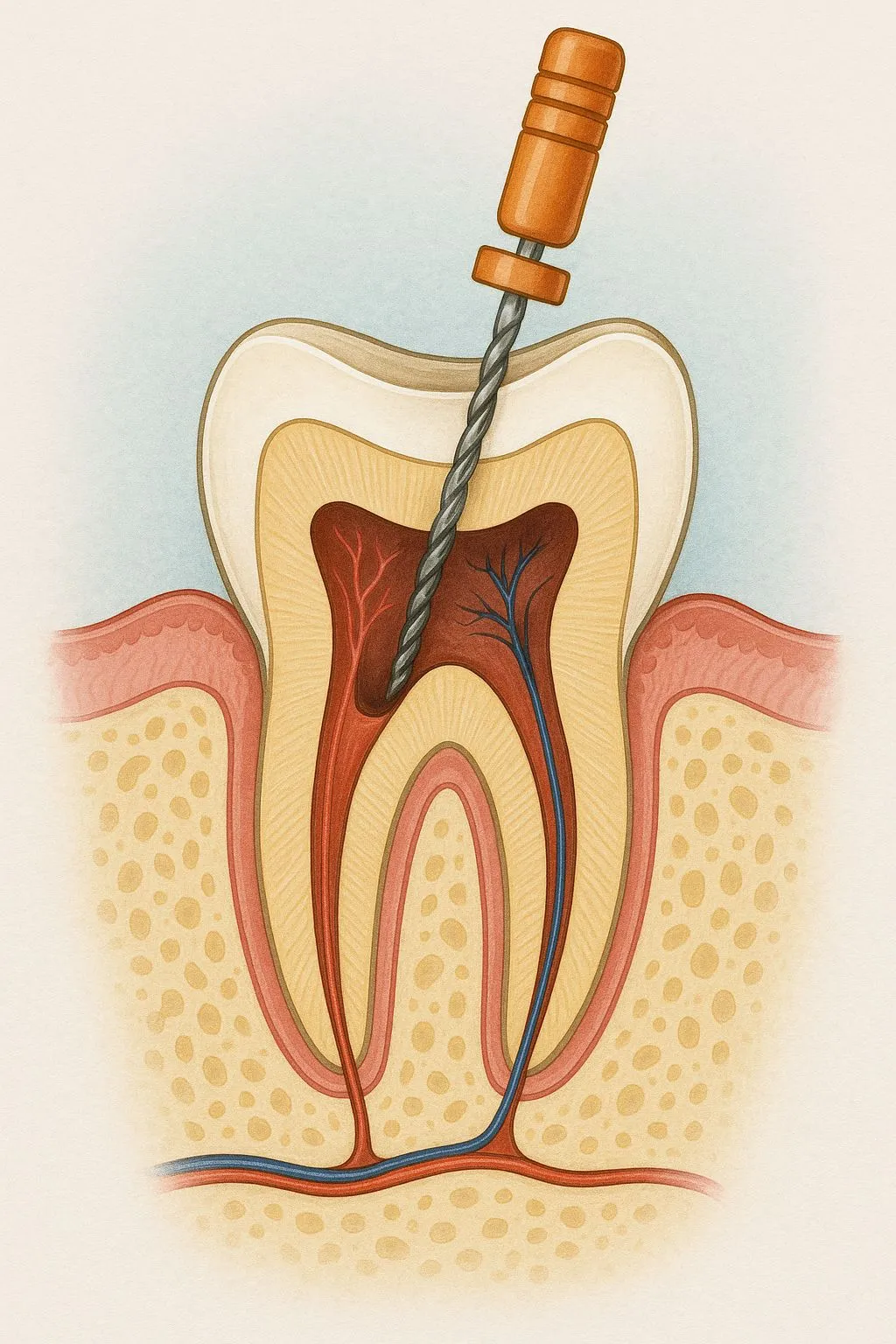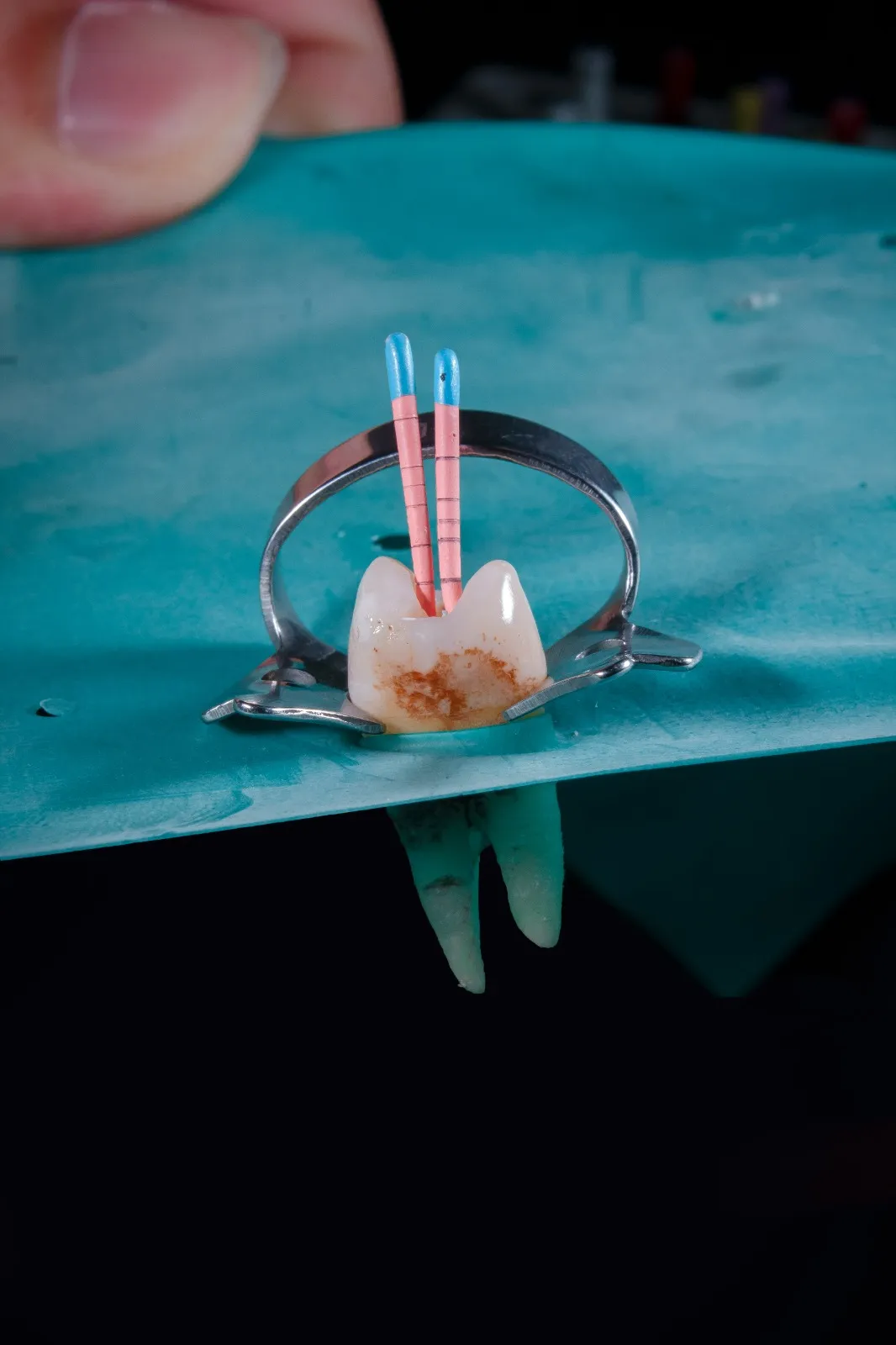Root Canal: What is It and How Long Does It Take?
Tooth pain? A root canal is a simple, pain-relieving fix to save your natural tooth. Learn how it works, what to expect, and why it’s a trusted solution for a healthy smile.

A root canal is a common dental procedure designed to save a tooth that’s been damaged by infection or inflammation deep inside its core. Far from the scary stories you might have heard, modern root canals are straightforward, effective, and often no more uncomfortable than getting a filling. This treatment is crucial for preserving your natural tooth, preventing the need for extraction, and maintaining your smile's health and function. Contrary to old myths, root canals aren’t painful ordeals—they’re a reliable way to relieve pain and protect your oral health.
Did you know that as early as 200 BCE, the Ancient Egyptians were treating tooth infections by draining abscesses, an early form of root canal therapy? Or that the term “root canal” was coined in the 19th century, named after the tooth’s internal canal system? In this article, we’ll break down what a root canal is, how long it takes, and what patients can expect, providing clear, science-backed information in a way everyone can understand.
What is a Root Canal?
A root canal, or endodontic therapy, treats infection or inflammation in the tooth’s pulp—the soft tissue inside containing nerves, blood vessels, and connective tissue. This damage can come from deep decay, a cracked tooth, trauma, teeth grinding (bruxism), or irritation from large fillings. Left untreated, the infection can spread to the jawbone or nearby teeth, causing pain, swelling, or abscesses. The procedure removes the damaged pulp, cleans the tooth’s inner canals, and seals them to prevent further issues, saving the natural tooth.
Did you know that over 15 million root canals are done worldwide every year? In the UK alone, about 250,000 happen annually. That’s how common and trusted this fix is!

What Increases Your Risk of Needing a Root Canal?
Not everyone needs a root canal, but certain things make it more likely that your tooth’s pulp could get infected or inflamed. Here’s what can up your chances:
- Skipping brushing or flossing: Letting plaque and bacteria build up can lead to deep cavities that reach the tooth’s core. Brushing twice a day and regular checkups cut this risk by 40% (Source: NHS Oral Health Report, 2024).
- Untreated cavities: Deep decay that goes beyond the tooth’s surface is the top reason for root canals, causing 60% of cases in the UK (Source: British Endodontic Society).
- Bumps or bangs to your tooth: A hit from sports, an accident, or even crunching hard foods like ice can crack your tooth or hurt the pulp, letting bacteria sneak in.
- Grinding your teeth: Clenching or grinding, which affects 1 in 10 UK adults, wears down teeth and can irritate the pulp, especially in your back teeth.
- Big or repeated fillings: Lots of fillings or deep ones near the pulp can weaken your tooth or cause irritation, making infection more likely over time.
- Gum disease: If your gums are unhealthy, bacteria can reach the tooth’s roots. This is a problem for nearly half of adults aged 35 and above.
- Consuming too many sugary treats: Sugary snacks and drinks feed bacteria that cause decay, resulting in 30% of dental infections in the UK.
- Putting off dentist visits: Ignoring tooth pain or sensitivity lets minor problems grow. A 2022 survey found 25% the UK’s population delay dental care due to cost or anxiety.
How It’s Done
Here’s how dentists carry out this precise procedure:
- Diagnosis: Your dentist uses X-rays to check the tooth’s damage and plan the treatment.
- Anesthesia: Local anesthesia numbs the area so you’re comfortable. For nervous patients, sedation options may be available.
- Isolation: A rubber dam keeps the tooth dry and free from saliva, ensuring the area remains clean.
- Pulp Removal: The dentist prepares a small hole in the tooth’s crown to reach and remove the infected pulp.
- Cleaning and Shaping: Tiny tools, often equipped with high-tech gadgets for accuracy, clean and shape the root canals to eliminate all bacteria and debris.
- Filling and Sealing: The canals are filled with a safe material called gutta-percha and sealed with dental cement to stop future infections.
- Restoration: A temporary or permanent filling closes the hole, and a crown is often suggested to protect the tooth long-term, especially for back teeth.
This procedure, performed by general dentists or endodontists (root canal specialists), stops the infection from spreading, keeps your tooth functioning, and helps restore your mouth to good health.

How Long Does the Procedure Take?
The time it takes to perform a root canal depends on the tooth’s complexity and the severity of the infection. Most are split between 1-2 visits, with each session lasting 60-120 minutes.
Factors That Affect Duration
Several factors can extend or shorten the time needed for a root canal, depending on the tooth and the case’s complexity:
- Tooth Complexity: Back teeth with multiple canals take longer than front teeth with one root.
- Infection Severity: Abscesses or complex, curved canals require additional cleaning time.
- Emergency Cases: Urgent cases might focus on draining the infection first, finishing later.
- Retreatment: Fixing a failed root canal can take 2-3 hours to remove old fillings and re-clean.
- Initial Consultation: A separate visit for X-rays and checks might add to the timeline.
Does It Hurt?
Thanks to modern anesthesia, a root canal is usually no worse than getting a filling. You might feel some pressure or vibrations from the tools during the procedure, but serious pain is rare. If the tooth’s already sore or very infected, you could feel a bit of discomfort if the numbing doesn’t fully kick in, but your dentist can add more anesthesia if needed. It’s uncommon, but you might feel a pinch if the numbing starts to wear off.
A 2022 UK-based survey found that 65% of people are scared of root canals because of old horror stories, but 90% said it was way less painful than they expected, and 70% thought it felt like a regular filling.

What’s the Recovery Like?
Recovery from a root canal is usually quick and easy. Your mouth will be numb for 2-4 hours after, due to the anesthesia, so don’t chew until the feeling’s back to avoid biting your cheek or tongue. You might have some soreness or swelling for a few days, but painkillers like paracetamol or ibuprofen usually do the trick. To help healing:
- Skip hot or cold foods, as the tooth might be sensitive to temperature.
- Don’t chew on the treated tooth until it’s fully fixed with a filling or crown.
- Prop your head up when sleeping for 1-2 nights to ease swelling, especially for bad infections.
- Avoid smoking, as it can slow healing and raise infection risk.
- If your dentist gives you antibiotics, take them to clear any leftover infection.
Most people are back to normal the next day, with full recovery in about a week. Your dentist will give you clear aftercare tips, like brushing, flossing, and avoiding hard foods to keep the tooth safe.
What Are the Long-Term Outcomes?
Root canals have an 85-95% success rate, and most treated teeth last a lifetime if you take care of them. A 2021 study showed that teeth with root canals and crowns have a 97% chance of lasting 10 years, compared to 83% for those with just fillings, so getting a crown really matters. After treatment, the tooth works like a normal one for chewing and looks great, as long as it’s protected with a crown or strong filling. Without a crown, the tooth can get brittle and might crack. Brushing, flossing, and regular dentist visits keep it in great shape.
In rare cases (5-10%), the tooth may become infected again, requiring a new root canal or a minor surgery to remove the root tip.
Sometimes after root canal treatment, the tooth can be expected to darken over a long period of time. Whitening, crowns, or veneers can address this issue.
.webp)
Is It Safe?
Root canals are extremely safe, with complications occurring in less than 5% of cases. Risks such as reinfection, a broken tool, or rare allergies to materials (like numbing agents) are minimal with today’s technology. For individuals with heart issues, root canals reduce the risk of serious infections by addressing the underlying problem. Old myths linking root canals to diseases like cancer have been totally debunked by science. Dentists follow strict rules and use top-notch tools to keep you safe and comfortable.
Are There Any Alternatives?
The main alternative is removing the tooth, but that can cause other teeth to shift, bone loss, and pricey fixes like implants or bridges. Keeping your natural tooth is usually the better choice. Other options include:
- Pulp Capping: For early damage with just a bit of pulp exposed, a protective layer might work (not common for serious cases).
- Partial Pulpotomy: For kids with growing teeth, only part of the pulp is taken out.
- Temporary Relief: Antibiotics and painkillers can help in emergencies until you get proper treatment.
- Monitoring: If the tooth’s not causing trouble, it might be watched, but this risks the infection getting worse.
Conclusion
Root canals are a safe, effective way to save a damaged tooth, relieve pain, and keep your smile shining. The procedure usually takes 60-120 minutes per visit, with 1-2 sessions depending on the tooth. Recovery’s fast, with most people feeling back to normal in a day and fully healed in a week. With an 85-95% success rate, a treated tooth can last a lifetime with good care.
If you’re dealing with tooth pain or signs of infection, don’t wait—talk to your dentist to figure out your options. Book an appointment with your local dental practice to keep your oral health in check today.






